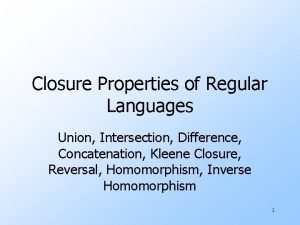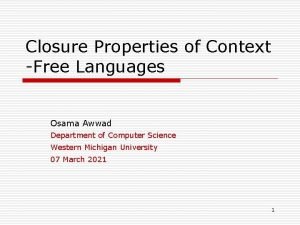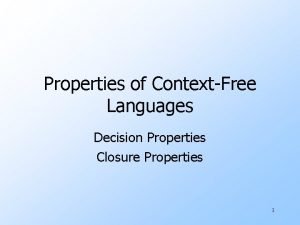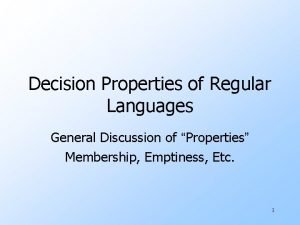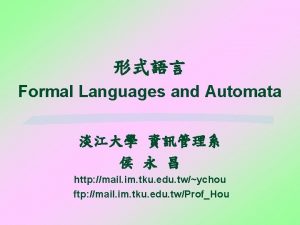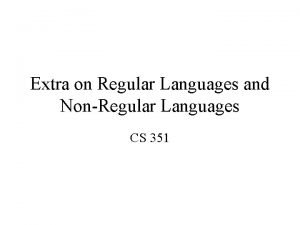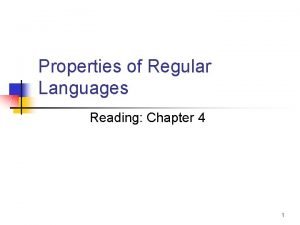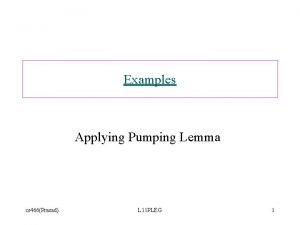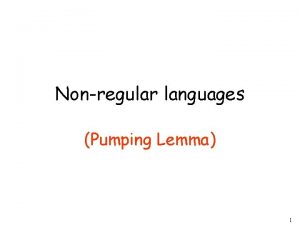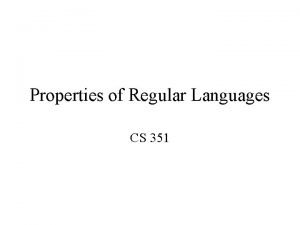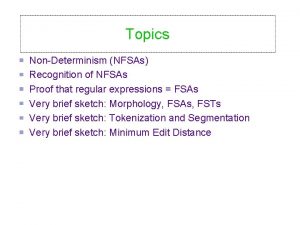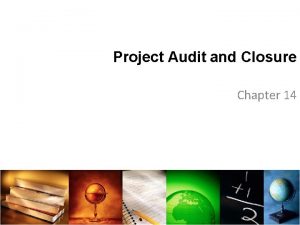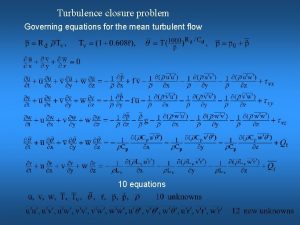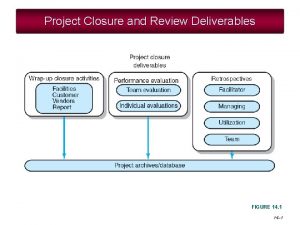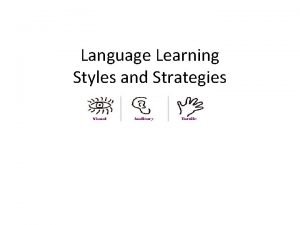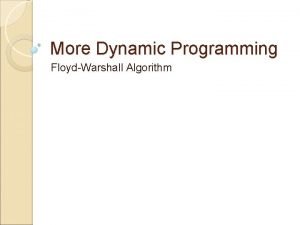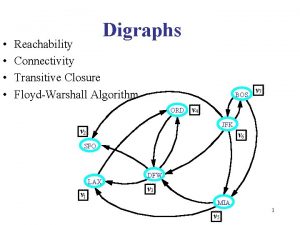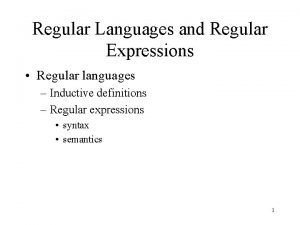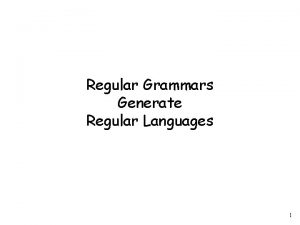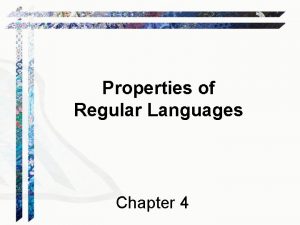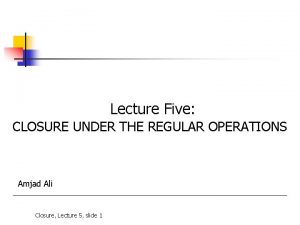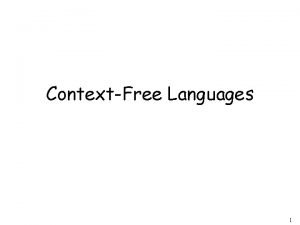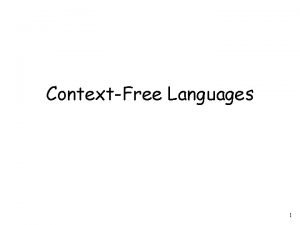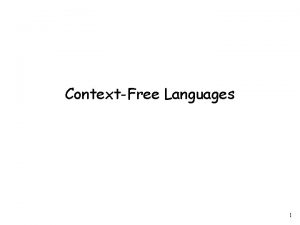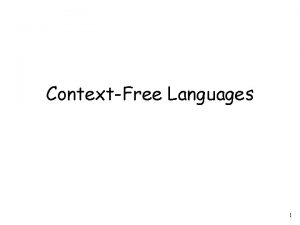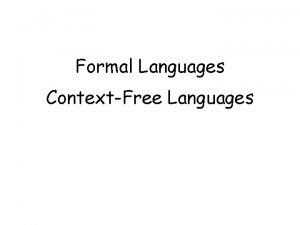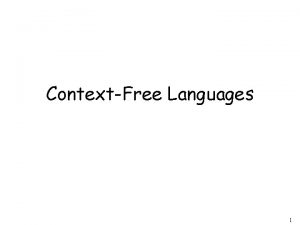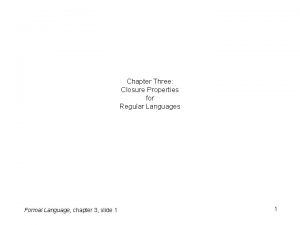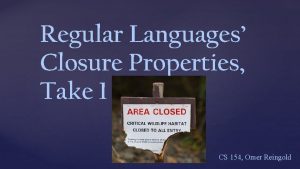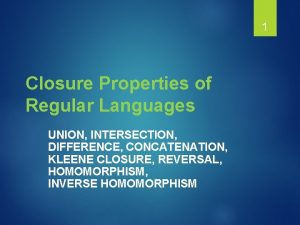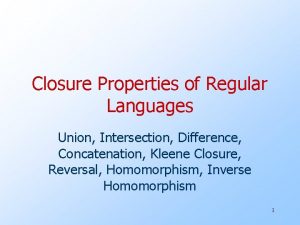Regular Languages Regular Operations Closure Regular Languages We





















- Slides: 21

Regular Languages, Regular Operations, Closure

Regular Languages • We say that a language L is regular iff there is a DFA that accepts L. • The regular languages is the set of languages that dfas accept.

Regular Operations The regular operations are the following: • Union (U) • Concatenation (o) • Star (*)

Regular Operations • • • L 1 U L 2 = {x|x L 1 or x L 2} L 1 o L 2 = {xy|x L 1 and y L 2} Lk = L o … o L, k times , L 0 = {ε} L* = Lk for any k ≥ 0 L+ = Lk for any k > 0

Regular Operations Examples L 1 = {a, b}, L 2 = {b, c} • L 1 U L 2= {a, b, c} • L 1 o L 2 = {ab, ac, bb, bc} • L 1 2 = {aa, ab, ba, bb} • L 1* = {ε, a, b, aa, ab, ba, bb, aaa, aab, aba, abb, baa, bab, bba, bbb, aaaa, aaab, aaba, …} • Σ* is the set of all possible strings of an alphabet Σ.

Closure To show that a set is closed under an operation we should prove that, if we apply the operation on members of the set then the result belongs in the set. Example: The set of natural numbers N is closed under +, because if we add any two numbers in N the result is still in N. However, N is not closed under -, since 3 -5 = -2 which is not in N. Question: Is Z closed under -? What about / ?

Regular Languages are closed under union. • We should prove that if L 1 and L 2 are regular then L = L 1 L 2 is also regular. • Since L 1 and L 2 are regular there exist DFAs M 1 and M 2 that accept them. • It suffices to show that there exist a DFA M that accepts L. • We construct a DFA that accepts L.

Proof idea • I want to construct a DFA M that will simulate both M 1 and M 2 running in parallel. This machine should keep track of what happened to either machine after following a symbol a of the alphabet.

Proof idea • Start from q 01 in M 1 and q 02 in M 2. After following a symbol a the first machine will be in state q 1 and the second in q 2. q 01 q 02 a a q 1 q 2

Proof idea • I want the new machine to remember both states that can be reached after following a. Thus I am going to create a new state containing a pair of both states. q 01 a q 1 q 02 a q 2 q 1 q 2

Proof idea • Starting from (q 01, q 02) after following a, M will be in state (q 1, q 2). q 01 a q 1 q 02 a q 1 q 2

Proof idea • Now it is left to find which of these pairs of states will be the accepting ones. • I want to construct a DFA M that accepts the union L 1 U L 2, that is all the strings which are accepted by either of the DFAs M 1, M 2.

Proof idea • Machine M 1 accepts a string s if after consuming s it is in an accepting state q. F 1. b ab q 01 q. F 1 s= abb

Proof idea • Thus any pair (q. F 1, q 2) that contains q. F 1 should be an accepting state in M. b ab q 01 q. F 1 q 02 abb q 02 q 2 s= abb q. F 1 q 2

Proof idea • Same for M 2. If q. F 2 is an accepting state, any state (q 1, q. F 2) should be an accepting state of M. a ab q 01 q 02 aba q 02 q. F 2 s= aba q 1 q. F 2

A DFA that accepts L 1 U L 2 Assume that M 1 = {Q 1, Σ , δ 1 , q 01 , F 1} and M 2 = {Q 2, Σ , δ 2 , q 02 , F 2}. Then M = {Q, Σ, δ, q 0, F}, where • Q = Q 1 x Q 2 • δ((q 1, q 2), a) = (δ 1(q 1, a), δ 2(q 2, a)) • q 0 = (q 01, q 02) • F = (Q 1 x F 2) (F 1 x Q 2)

Example • Construct a DFA that accepts the language L = L 1 U L 2, where : – L 1 = {s|s contains an odd number of 1} and – L 2 = {s|s contains an even number of 0}.

Example • L 1 = {s|s contains an odd number of 1} 1 q 01 0 0 q 11 1

Example • L 2 = {s|s contains an even number of 0} 1 0 q 00 q 10 0 1

Example • L = L 1 U L 2 1 0 q 01 1 q 11 1 0 q 01 1 0 q 00 q 10 0 q 00 q 11 0 1 1 0 0 0 1 q 10 q 01 q 10 q 11 1

Question • What if I would like to construct a DFA that accepts the intersection of two regular languages? (in other words show that the regular languages are closed under the intersection).
 Closure properties of regular languages
Closure properties of regular languages Right linear grammar
Right linear grammar Which grammar generates regular language
Which grammar generates regular language Cfl closed under complement
Cfl closed under complement Closure properties of context free languages
Closure properties of context free languages Decision properties of regular languages
Decision properties of regular languages Properties of regular languages
Properties of regular languages Decision properties of regular languages
Decision properties of regular languages Regular and irregular languages
Regular and irregular languages Decision properties of regular languages
Decision properties of regular languages Pumping lemma for regular languages
Pumping lemma for regular languages Pumping lemma non regular languages examples
Pumping lemma non regular languages examples Decision properties of regular languages
Decision properties of regular languages Kleene closure
Kleene closure Project audit and closure
Project audit and closure Turbulence closure problem
Turbulence closure problem Wrap up closure checklist
Wrap up closure checklist Closure-oriented/judging vs. open/perceiving
Closure-oriented/judging vs. open/perceiving Lab torque tester
Lab torque tester Safeseal closure system
Safeseal closure system Floyd warshall path reconstruction
Floyd warshall path reconstruction Strongly connected
Strongly connected
